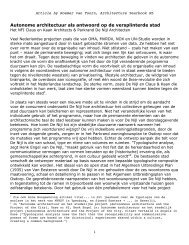ABCD Lars & Roemer
ABCD Lars & Roemer
ABCD Lars & Roemer
Create successful ePaper yourself
Turn your PDF publications into a flip-book with our unique Google optimized e-Paper software.
<strong>Roemer</strong> van Toorn in conversation with <strong>Lars</strong> Lerup <br />
there are many complex ethical issues intertwined within the<br />
fundamentally positive design activity.<br />
How do I judge architecture? When I do, mostly in my mind, I look for<br />
“the cracks where the light comes in.” I am thinking here of Peter<br />
Celsing’s central bank in Stockholm, for me one of the most intriguing<br />
buildings of the twentieth century. It is full of surprises and strange<br />
gaps of reason, beginning at the majestic granite façade. At first<br />
appearing solid and heroic, it becomes upon closer scrutiny<br />
profoundly unsettling: is it structure or mere surface – carrying or<br />
merely hanging? No visual scrutiny helps here; the eye must rely on<br />
faith – Hinc Robur et Securitas (In This Rests Our Security), as<br />
Swedish paper currency declares. Although I wrote a major research<br />
paper on the bank, I never wanted to solve the puzzle, just as I prefer<br />
not to know how someone does a card trick. Unfortunately for me,<br />
there are very few if any buildings filled with such enigmatic power.<br />
The closest I have found is in the field of painting, especially Giogio de<br />
Chirico’s oeuvre, both the radical and the neoclassical periods of his<br />
work.<br />
Being halbstark, or half-strong (referring to the German word for<br />
1950s adolescent rebels), may be a central tenet in my approach to<br />
evaluating architecture. Simultaneous weakness and strength. Wise<br />
counsel given that a unified theory of everything has yet to account for<br />
gravity.<br />
H as in Hesitation<br />
For a moment I was not sure which word to choose, but than I understood (from<br />
your writings on “The Metropolitan Architect” in After the City) that the<br />
architect’s Hand, his/her principle of Hope, and the architect’s House (habitation<br />
proper) only get their true meaning through the concept of Hesitation. Without<br />
10






